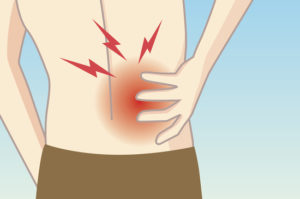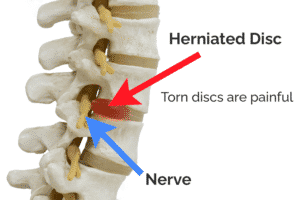 What is an Annular Tear?
What is an Annular Tear?
An annular tear occurs in the ligament that surrounds the nucleus of your spinal discs with cartilage fibers called the annulus fibrosus. Spinal disc nucleus’ have a consistency of jelly and are shock absorbers for the spine as it moves. If the annulus fibrosus tears the disc nucleus can break through the tear and put pressure on nearby spinal nerves. The outer annular fibrosus ring has a lot of nerve fibers, so even just a tear of the outer wall can be very painful, and also puts the disc at risk for future tears.
Healthy spinal discs allow you to move your back comfortably and absorb the everyday pressure on your spine and vertebrae. Even if you’re just sitting or standing the gravitational force on your spine can cause slight compression, so having healthy discs is ideal. But sometimes our discs grow weak and give way to an annular tear. So what’s the cause of an annular tear?
Annular Tear Causes
Damage to your spinal discs usually happens due to weak or dehydrated discs. The most common cause is degenerative disc disease, which happens as you naturally age and your discs start to dry out. However, not everyone experiences symptoms from this, since even if you have DDD the annular fibrosus might not tear or cause any pain. The process can be sped up with repetitive motions of the back, and as the disc drys out it loses some of the natural flexibility.
Bone spurs, also known as osteophytes, are hard bumps of bone that form on the ends of bones. Generally they are more commonly found in joints where two bones meet, and can pop up in your hands, neck, spine, knees and other areas. They can also cause annular tears if they go into the spinal disc space, as well as other issues that might cause pain.
A traumatic injury also has a chance at causing an annular tear, since it’s usually a sudden and harsh impact that affects the spine. Examples of an injury like this are car accidents, sports injuries and a sudden fall. All of these can cause damage to the spine including your spinal discs.
Annulus Fibrosus and Disc Desiccation
As we mentioned earlier the spine goes through a process of degeneration of discs which involves the drying out of spinal discs. This dehydration is called disc desiccation. Your discs are filled with fluid, and with age the fluid starts to dry out and gets replaced with fibrocartilage, which is tough fibrous tissue that makes up the outer disc. If you are experiencing disc desiccation you will feel a stiffness in your back and possibly pain, weakness and tingling / numbness. Disc desiccation and annulus fibrosus often go hand in hand since people with disc desiccation are more at risk for an annular tear.
 Is an Annular Tear Serious?
Is an Annular Tear Serious?
Many annular tears will heal themselves over time without much issue. Minor annular tears don’t cause much pain, and you might not even fully notice unless the tear progresses and gets worse. As the tear gets bigger the inner jelly like nucleus of the spinal disc will bulge outwards and pinch spinal cord nerves. Nerves are very sensitive, so even a slight pinch can cause a good amount of pain. The pain can be chronic in the back or neck, and frequently causing lower back pain.
There are also different kinds of annular tears. Concentric tears occur in the outer wall of the disc all the way through as to fully or partially separate layers of the annular fibrosus. Peripheral tears are just outer wall tears that do not originate from the inner layer of the disc, and only exist on the periphery. Radial tears originate in the inner layer and slowly tear through the outer layer, which can cause a herniated disc.
Annular Tear vs Herniated Disc
An annular tear might lead to a herniated disc, but they aren’t the same thing. Herniated discs start with a tear in the inner then outer layer of the disc, then the nucleus bulges outwards until it breaches the outer layer. Even a disc bulge causes pain if it pinches a nerve, but a herniated disc can be even more painful. Annular tears don’t necessarily have symptoms at first, but they do get worse if you continue to put pressure on a disc with a mild tear. If the tear gets worse the symptoms might appear like pain in the back, radiating pain down the body, muscle weakness, and tingling or numbness.

Herniated discs have similar symptoms like back pain, weakness and numbness, but one side of the body might be more affected than the other.The pain can also shoot down through the buttocks and legs. Herniated discs, however, may require surgery if the symptoms are extremely severe or more conservative treatment approaches aren’t working.
Annular Tear Treatment
Treating an annular tear is generally managing the pain, while reducing inflammation caused by the tear so it can heal properly over time. Non-steroid anti-inflammatory medications are standard treatment for annular tears, as well as physical therapy. If you need further pain management there are steroidal injections available that are very effective at inflammation reduction and also give lasting pain relief in the targeted area. Physical therapy goes hand in hand with pain management since it helps strengthen supporting muscles and improves much needed flexibility when recovering from an injury.


